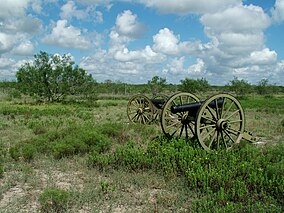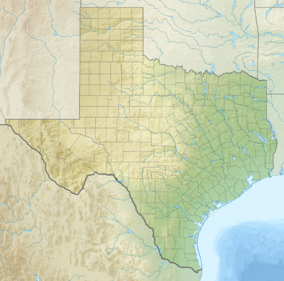| Palo Alto Battlefield National Historical Park | |
|---|---|
 Palo Alto battlegrounds today | |
Location in Texas | |
| Location | Cameron County, Texas, U.S. |
| Nearest city | Brownsville, Texas |
| Coordinates | 26°1′17″N 97°28′50″W / 26.02139°N 97.48056°W |
| Area | 3,357.42 acres (13.5870 km2) 1,039.62 acres (420.72 ha) federal |
| Established | November 10, 1915 |
| Visitors | 36,707 (in 2012)[1] |
| Governing body | National Park Service |
| Website | Palo Alto Battlefield National Historical Park |
Palo Alto Battlefield National Historical Park | |
Former U.S. National Historic Site | |
| Built | 1846 |
| NRHP reference No. | 66000812 |
| Significant dates | |
| Designated NHL | December 19, 1960[2] |
| Designated NHP | March 30, 2009 |
| Designated NHS | November 19, 1978 |
| Delisted NHS | March 30, 2009 |
Palo Alto Battlefield National Historical Park near Brownsville, Texas, United States, is a National Park Service unit which preserves the grounds of the May 8, 1846, Battle of Palo Alto. It was the first major conflict in a border dispute that soon precipitated the Mexican–American War. The United States Army victory here made the invasion of Mexico possible. The historic site portrays the battle and the war, and its causes and consequences, from the perspectives of both the United States and Mexico.
The National Park Service has acquired a little more than a third of the authorized land for the park, including the 300 acres (1.2 km2) southern core battlefield tract, which served as the location for Mexican forces during the Battle of Palo Alto. Private landowners still control some 2,000 acres (8.1 km2) of the battlefield. Honey Mesquite (Prosopis glandulosa), although a native plant, is present in an unusually high concentration, altering the cultural landscape and threatening the natural and cultural resources at the park.
The park's visitor center features exhibits about the battle and the Mexican–American War, as well as a 15-minute video titled "War on the Rio Grande". A half-mile trail leads to an overlook of the battlefield and includes interpretive panels.
- ^ "NPS Annual Recreation Visits Report". National Park Service. Retrieved November 4, 2013.
- ^ Staff (June 2011). "National Historic Landmarks Program: Listing of National Historic Landmarks by State, Texas" (PDF). National Park Service. Retrieved January 10, 2018..

